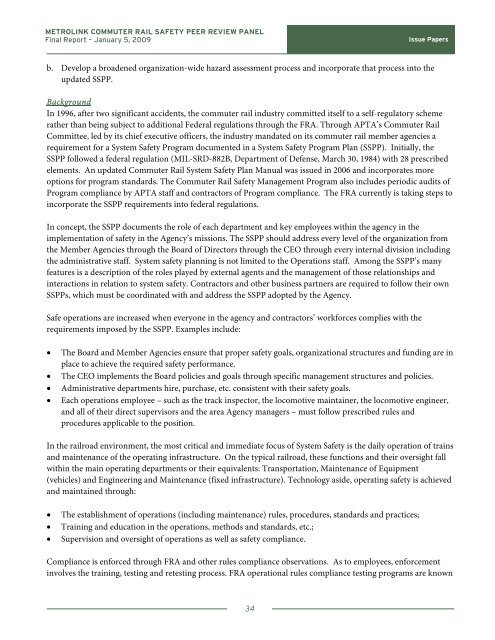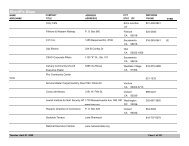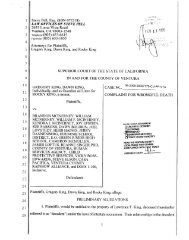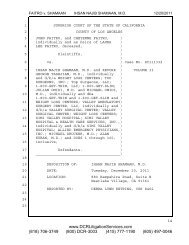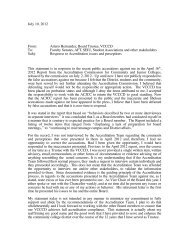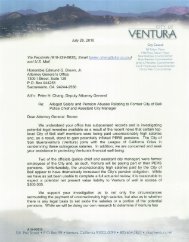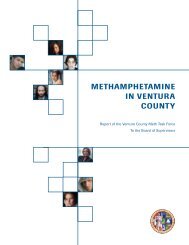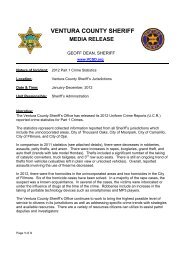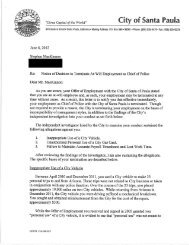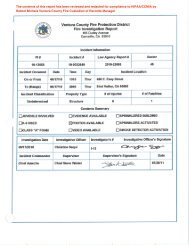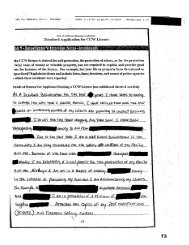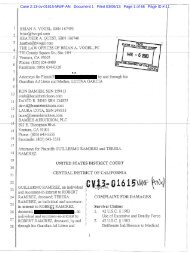Metrolink peer review report - Ventura County Star
Metrolink peer review report - Ventura County Star
Metrolink peer review report - Ventura County Star
You also want an ePaper? Increase the reach of your titles
YUMPU automatically turns print PDFs into web optimized ePapers that Google loves.
METROLINK COMMUTER RAIL SAFETY PEER REVIEW PANEL<br />
Final Report – January 5, 2009<br />
Issue Papers<br />
b. Develop a broadened organization-wide hazard assessment process and incorporate that process into the<br />
updated SSPP.<br />
Background<br />
In 1996, after two significant accidents, the commuter rail industry committed itself to a self-regulatory scheme<br />
rather than being subject to additional Federal regulations through the FRA. Through APTA’s Commuter Rail<br />
Committee, led by its chief executive officers, the industry mandated on its commuter rail member agencies a<br />
requirement for a System Safety Program documented in a System Safety Program Plan (SSPP). Initially, the<br />
SSPP followed a federal regulation (MIL-SRD-882B, Department of Defense, March 30, 1984) with 28 prescribed<br />
elements. An updated Commuter Rail System Safety Plan Manual was issued in 2006 and incorporates more<br />
options for program standards. The Commuter Rail Safety Management Program also includes periodic audits of<br />
Program compliance by APTA staff and contractors of Program compliance. The FRA currently is taking steps to<br />
incorporate the SSPP requirements into federal regulations.<br />
In concept, the SSPP documents the role of each department and key employees within the agency in the<br />
implementation of safety in the Agency’s missions. The SSPP should address every level of the organization from<br />
the Member Agencies through the Board of Directors through the CEO through every internal division including<br />
the administrative staff. System safety planning is not limited to the Operations staff. Among the SSPP’s many<br />
features is a description of the roles played by external agents and the management of those relationships and<br />
interactions in relation to system safety. Contractors and other business partners are required to follow their own<br />
SSPPs, which must be coordinated with and address the SSPP adopted by the Agency.<br />
Safe operations are increased when everyone in the agency and contractors’ workforces complies with the<br />
requirements imposed by the SSPP. Examples include:<br />
• The Board and Member Agencies ensure that proper safety goals, organizational structures and funding are in<br />
place to achieve the required safety performance.<br />
• The CEO implements the Board policies and goals through specific management structures and policies.<br />
• Administrative departments hire, purchase, etc. consistent with their safety goals.<br />
• Each operations employee – such as the track inspector, the locomotive maintainer, the locomotive engineer,<br />
and all of their direct supervisors and the area Agency managers – must follow prescribed rules and<br />
procedures applicable to the position.<br />
In the railroad environment, the most critical and immediate focus of System Safety is the daily operation of trains<br />
and maintenance of the operating infrastructure. On the typical railroad, these functions and their oversight fall<br />
within the main operating departments or their equivalents: Transportation, Maintenance of Equipment<br />
(vehicles) and Engineering and Maintenance (fixed infrastructure). Technology aside, operating safety is achieved<br />
and maintained through:<br />
• The establishment of operations (including maintenance) rules, procedures, standards and practices;<br />
• Training and education in the operations, methods and standards, etc.;<br />
• Supervision and oversight of operations as well as safety compliance.<br />
Compliance is enforced through FRA and other rules compliance observations. As to employees, enforcement<br />
involves the training, testing and retesting process. FRA operational rules compliance testing programs are known<br />
34


